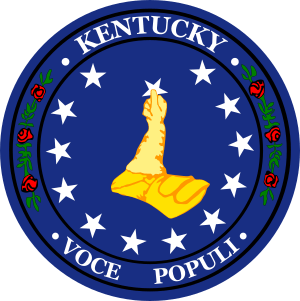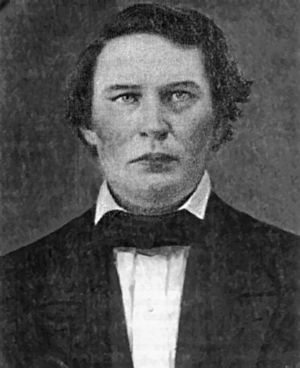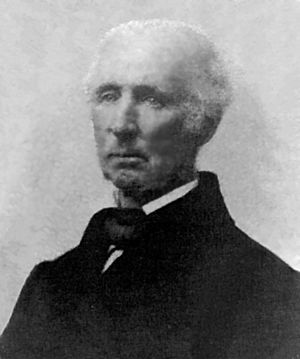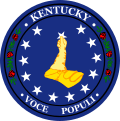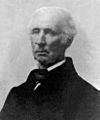Confederate government of Kentucky facts for kids
The Confederate government of Kentucky was like a "shadow" government set up in Kentucky during the American Civil War. It was created by a group of people who supported the Confederacy. These supporters and delegates from Kentucky counties formed this government.
This shadow government never took over from the elected government in Frankfort. The state's elected lawmakers mostly supported the Union. However, the state governor was more on the Confederate side. The shadow government also didn't have full support from all Kentuckians. It only controlled areas where Confederate armies were present. At its largest in 1861 and early 1862, this was about half the state.
Even so, the Confederate States of America recognized this provisional government. Kentucky officially joined the Confederacy on December 10, 1861. Kentucky was the last state to join. It was shown by the 13th star in the middle of the Confederate battle flag.
Bowling Green, Kentucky, was chosen as the Confederate capital of Kentucky. This happened at a meeting in nearby Russellville. Because of the war, this government often had to move. It traveled with the Army of Tennessee for most of its existence. For a short time in 1862, the Confederate Army controlled Frankfort. This was the only time a Union state capital was captured by Confederate forces. During this time, General Braxton Bragg tried to make the provisional government the official one. But Union General Don Carlos Buell surprised the inauguration ceremony. He forced the Confederate government out of the state for good. After that, the government mostly existed only on paper. It ended when the war finished.
This provisional government elected two governors. George W. Johnson was chosen at the Russellville Convention. He served until he died at the Battle of Shiloh. Richard Hawes was elected to replace Johnson. He served for the rest of the war.
Contents
Why Kentucky Was Divided
People in Kentucky had different ideas about the Civil War. The state had strong business ties with Northern cities like Pittsburgh and Cincinnati. But it also shared many traditions and economic links with the Southern states. Many Kentuckians had strong Unionist beliefs, especially in the eastern part of the state.
Because Kentucky had ties to both the North and the South, it had a lot to lose from a war. Many slaveholders in Kentucky also felt that keeping slavery was best done by staying in the Union.
The 1860 United States presidential election showed how mixed Kentucky's feelings were. John Bell got 45% of the votes. John C. Breckinridge got 36%. Stephen Douglas got 18%. Abraham Lincoln got less than 1%. This showed that most Kentuckians were against both states leaving the Union and the North forcing them to stay. They wanted to find a middle ground.
Most Kentuckians believed their state should try to make peace between the North and South. On December 9, 1860, Kentucky Governor Beriah Magoffin suggested a plan to other Southern governors. He wanted them to agree with the North on things like enforcing the Fugitive Slave Act. He also wanted a guarantee of free use of the Mississippi River. But events moved too fast for these talks to happen.
Governor Magoffin asked the Kentucky General Assembly (the state's lawmakers) to meet on December 27, 1860. He wanted them to hold a meeting to decide Kentucky's path in the conflict. But Union supporters in the assembly didn't want to risk the state voting to leave the Union. So, they voted against holding such a meeting. However, the assembly did send delegates to a Peace Conference of 1861 in Washington, D.C. They also asked Congress to find ways to solve the crisis.
After the attack on Fort Sumter, President Lincoln asked Governor Magoffin for four regiments of soldiers. Magoffin, who supported the Confederacy, refused. He said he would not send "a man nor a dollar for the wicked purpose of subduing my sister Southern states." Both parts of Kentucky's General Assembly then declared Kentucky neutral in the war. Governor Magoffin made this official on May 20.
In a special election on June 20, Unionist candidates won nine out of Kentucky's ten seats in Congress. Confederate supporters only won in the Jackson Purchase area. This region had strong economic ties to Tennessee. Many Southern supporters didn't even vote, expecting to lose. Unionists won almost 90,000 out of 125,000 votes.
Confederate supporters faced another defeat in the August 5 election for state lawmakers. This election gave Unionists a very strong majority. They had 76-24 in the House and 27-11 in the Senate. From then on, the General Assembly often overturned Governor Magoffin's decisions that favored the South.
Historian Wilson Porter Shortridge explained that these elections showed most Kentuckians were against leaving the Union. But it didn't mean they fully supported Lincoln's war policy. He thought Kentuckians wanted peace. They believed electing Union candidates was the best way to get it.
Since leaving the Union was no longer an option, pro-Confederate groups strongly supported neutrality. Unionists, however, saw this as a way for them to secretly push for leaving the Union. The struggle between the two sides became clear on September 3. Confederate forces moved from Tennessee into Kentucky towns. Union forces responded by occupying Paducah.
On September 11, the lawmakers told Governor Magoffin to order only the Confederate forces to leave the state. The Governor disagreed, but the General Assembly overruled him. Magoffin then gave the order. The next week, the assembly officially asked for Union help. They also asked the governor to call out the state militia to join the Federal forces. Magoffin also disagreed with this, but the assembly overruled him again. Magoffin then agreed.
How the Government Was Formed
A pro-Confederate meeting was planned for September 21, with Breckinridge as a speaker. Unionists worried this meeting would lead to fighting. They sent troops to break up the meeting and arrest Breckinridge. Breckinridge and many other state leaders who supported the Confederacy fled Kentucky. These leaders later formed the core group that would create a shadow government for Kentucky. In his October 8 speech, Breckinridge declared that "The United States no longer exists. The Union is dissolved."
On October 29, 1861, 63 delegates from 34 counties met in Russellville. They met to talk about forming a Confederate government for Kentucky. Even though they had lost in elections, this group believed the Unionist government in Frankfort didn't represent most Kentuckians. Trigg County's Henry Burnett led the meeting. Scott County farmer George W. Johnson led the committee that wrote the final report. He also suggested some important ideas. The report called for a meeting to break ties with the Federal government. Both Breckinridge and Johnson helped organize this meeting.
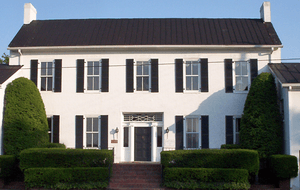
On November 18, 116 delegates from 68 counties met at the William Forst House in Russellville. Burnett was chosen to lead the meeting. He first suggested waiting until January 8, 1862, because he worried about the delegates' safety. But Johnson convinced most delegates to continue. By the third day, the military situation was so risky that the whole meeting had to move. They moved to a tower at Bethel Female College in Hopkinsville.
The first thing they did was approve an ordinance of secession, which meant formally leaving the Union. Next, since they couldn't write a full constitution, they decided that Kentucky's existing laws would stay in place. This was unless they went against the new government's actions. The delegates suggested a temporary government. It would have a council of ten members (one from each Kentucky congressional district). It would also have a governor who could appoint judges and other officials. There would also be a treasurer and an auditor.
They named Bowling Green as the Confederate State capital. This city was controlled by Confederate general Albert Sidney Johnston at the time. But they were smart enough to say the government could meet anywhere the council and governor thought was best. The convention adopted a new state seal. It showed an arm wearing armor with a star. This star came from a circle of twelve other stars.
| Job | Person in Office |
|---|---|
| Governor | George W. Johnson |
| Lieutenant Governor | Horatio F. Simrall |
| Secretary of State | Robert McKee |
| Treasurer | Theodore Legrand Burnett |
| Auditor | Josiah Pillsbury |
The convention chose Johnson as governor without anyone voting against him. Horatio F. Simrall was elected lieutenant governor. But he soon left for Mississippi to avoid Federal authorities. Robert McKee, who had been secretary for both meetings, was made secretary of state. Theodore Legrand Burnett was elected treasurer. But he resigned on December 17 to join the Confederate Congress. Warren County native John Quincy Burnham replaced him. The job of auditor was first offered to former Congressman Richard Hawes. But Hawes chose to stay in the military. So, the convention elected Josiah Pillsbury, also from Warren County. The legislative council chose Willis Benson Machen as its president.
On November 21, the day after the meeting, Johnson wrote to Confederate president Jefferson Davis. He asked for Kentucky to be admitted to the Confederacy. Burnett, William Preston, and William E. Simms were chosen to represent Kentucky to the Confederacy. For reasons not explained, Dr. Luke P. Blackburn, a Kentuckian living in Mississippi, was asked to go with them. Davis had some doubts about this new government. He worried because it bypassed the elected General Assembly. But he decided Johnson's request was good. On November 25, he suggested Kentucky join the Confederacy. Kentucky was admitted on December 10, 1861.
What the Government Did
On November 26, 1861, Governor Johnson spoke to the people of Kentucky. He blamed abolitionists for the breakup of the United States. He believed the Union and Confederacy were equally strong. He thought the only solution was a free trade agreement between them. He also said he would resign if Kentucky's General Assembly worked with Governor Magoffin. Magoffin himself criticized the Russellville Convention and the provisional government. He said it was important to follow the will of most Kentuckians.
During the winter of 1861, Johnson tried to make his new government seem real. But its power only reached as far as the Confederate Army controlled. At its peak, this was over half the state. Johnson couldn't raise the 46,000 troops the Confederate Congress asked for. Efforts to collect taxes and get citizens to give up their guns also failed. On January 3, 1862, Johnson asked the Confederate Congress for $3 million. This was to cover the government's costs. The Congress approved $2 million instead. But this money needed approval from Secretary of War Judah P. Benjamin and President Davis. Much of the government's money likely came from Kentucky congressman Eli Metcalfe Bruce. He made a lot of money during the war.
The council met on December 14 to choose representatives for the Confederacy's temporary congress. These people would serve for only two months. The temporary congress was replaced by a permanent two-house legislature on February 17, 1862. Kentucky was allowed two senators and 12 representatives in the permanent Confederate Congress. Governor Johnson and the council set election day for Confederate Kentucky on January 22. Voters could vote in any county they were in on election day. They could vote for all positions at once. In an election where more soldiers voted than civilians, only four of the temporary lawmakers were elected to the Confederate House. One temporary lawmaker, Henry Burnett, was elected to the Confederate Senate.
The provisional government did other small things in the winter of 1861. They passed a law to rename Wayne County to Zollicoffer County. This was in honor of Felix Zollicoffer, who died at the Battle of Mill Springs. Local officials were appointed in areas controlled by Confederate forces. This included many justices of the peace. When the Confederate government eventually ended, the legality of marriages performed by these justices was questioned. But they were eventually considered legal.
Leaving Kentucky and Governor Johnson's Death
After Ulysses S. Grant won at the Battle of Fort Henry, General Johnston pulled his troops out of Bowling Green and went into Tennessee on February 7, 1862. A week later, Governor Johnson and his government followed. On March 12, a newspaper reported that "the capital of Kentucky [is] now being located in a Sibley tent." This meant it was just a temporary tent.
Governor Johnson, despite his official role, his age (50), and a crippled arm, volunteered to fight. He served under Breckinridge at the Battle of Shiloh. On April 7, Johnson was badly wounded in his leg and stomach. He lay on the battlefield until the next day. A Union general, Alexander McDowell McCook, who knew Johnson, recognized and helped him. But Johnson died on a Union hospital ship. Kentucky's provisional government was left without a leader.
Richard Hawes Becomes Governor
Before leaving Bowling Green, Governor Johnson had asked Richard Hawes to come and help with the government. But Hawes was delayed because he had typhoid fever. After Johnson died, the provisional government elected Hawes as governor. He was still recovering from his illness. After he got better, Hawes joined the government in Corinth, Mississippi. He officially took office on May 31.
In the summer of 1862, rumors spread that Generals Bragg and Edmund Kirby Smith planned to invade Kentucky. The legislative council supported this plan. On August 27, Governor Hawes was sent to Richmond to tell President Davis how good the plan was. Davis didn't fully commit, but Bragg and Smith went ahead anyway.
On August 30, Smith won a big Confederate victory against a new Union force at the Battle of Richmond. Bragg also won a clear victory at the September 13 Battle of Munfordville. But the delay there cost him the chance to capture Louisville. Don Carlos Buell moved to occupy Louisville on September 25. Having lost Louisville, Bragg spread his troops out in central Kentucky cities. He waited for something to happen. A historian called this a "stupendously illogical decision."
Meanwhile, the leaders of Kentucky's Confederate government had stayed in Chattanooga, Tennessee. They were waiting for Governor Hawes to return. They finally left on September 18. They met up with Bragg and Smith in Lexington, Kentucky on October 2. Bragg was disappointed. Not many soldiers in Kentucky were joining the Confederate army. Wagon loads of weapons sent to arm new recruits were still unused. Bragg wanted to enforce the Confederate draft law to get more soldiers. So, he decided to install the provisional government in Frankfort, the recently captured state capital. On October 4, 1862, Hawes officially became governor. This was done by the Confederate legislative council. But during the celebration, the Confederate forces were caught off guard. Buell's artillery surprised them and forced them to retreat.
Decline and End
After the Battle of Perryville, the provisional government left Kentucky for the last time. Away from their home state, members of the legislative council went to places where they could find work or stay with relatives. They waited for Governor Hawes to call them together. Records show that on December 30, 1862, Hawes called the council, auditor, and treasurer to meet him in Athens, Tennessee on January 15, 1863. Hawes himself tried to get President Davis to remove Hawes' former superior, Humphrey Marshall, from command. He was not successful. On March 4, Hawes wrote to Davis. He said "our cause is steadily on the increase." He promised that another trip into Kentucky would work better than the first.
The government's money problems continued. Hawes was embarrassed to admit that no one seemed to know what happened to about $45,000. This money had been sent from Columbus to Memphis, Tennessee when the Confederates controlled Kentucky. Another big problem was Davis's decision in 1864. He would not let Hawes spend $1 million that had been secretly set aside in August 1861. This money was meant to help Kentucky stay neutral. Davis said the money couldn't be used for its original purpose. This was because Kentucky had already joined the Confederacy.
Late in the war, the provisional government mostly existed only on paper. However, in the summer of 1864, Colonel R. A. Alston asked Governor Hawes for help. He wanted Hawes to investigate crimes supposedly committed by Brigadier General John Hunt Morgan. This was during Morgan's latest raid into Kentucky. Hawes never had to act on the request. Morgan was suspended from command on August 10 and killed by Union troops on September 4, 1864.
There are no documents that say exactly when Kentucky's provisional government stopped working. It is believed to have ended when the Civil War concluded.
Images for kids
-
Seal of the provisional government of Kentucky, showing an arm holding the 13th star of the Confederacy. The motto voce populi is Latin for "by the voice of the people".
-
Kentucky senator and 1860 Presidential candidate John Breckinridge represented the states' rights position.
-
The William Forst House in Russellville
See also
 In Spanish: Gobierno Confederado de Kentucky para niños
In Spanish: Gobierno Confederado de Kentucky para niños


